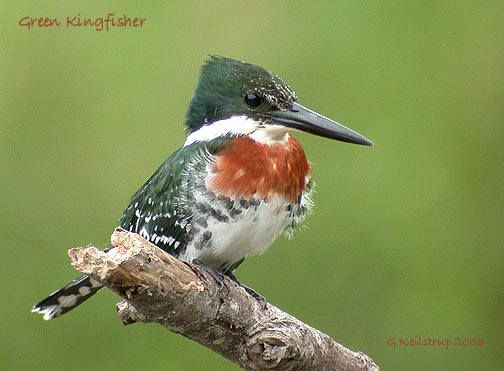| Line 2: | Line 2: | ||
;[[:Category:Chloroceryle|Chloroceryle]] americana | ;[[:Category:Chloroceryle|Chloroceryle]] americana | ||
[[Image:Green_Kingfisher.jpg|thumb|550px|right|Photo by {{user|glendak2|glendak2}} <br />[[Sabal Palm Audubon Center|Sabal Palm Grove Sanctuary]], Brownsville, Texas, USA, November 2003]] | [[Image:Green_Kingfisher.jpg|thumb|550px|right|Photo by {{user|glendak2|glendak2}} <br />[[Sabal Palm Audubon Center|Sabal Palm Grove Sanctuary]], Brownsville, Texas, USA, November 2003]] | ||
| − | + | ==Identification== | |
Green Kingfishers are small (approximately 19 to 20 cm [7.5 to 8 inches]), dark glossy green with white underparts, white collar, green spotting on breast and sides, and white markings on the wings and tail. Male has broad chestnut-colored breast band. Female has one or two green spotted breast bands. Typical kingfisher shape, with short tail and long, strong bill. | Green Kingfishers are small (approximately 19 to 20 cm [7.5 to 8 inches]), dark glossy green with white underparts, white collar, green spotting on breast and sides, and white markings on the wings and tail. Male has broad chestnut-colored breast band. Female has one or two green spotted breast bands. Typical kingfisher shape, with short tail and long, strong bill. | ||
| Line 11: | Line 11: | ||
==Habitat== | ==Habitat== | ||
Riparian woodlands; shade trees on the banks of rivers and resacas, preferring sheltered pools | Riparian woodlands; shade trees on the banks of rivers and resacas, preferring sheltered pools | ||
| − | + | ==Behaviour== | |
Green Kingfishers like shaded, tree-lined pools and streams with clear water. Will sit for long periods of time on low perch scanning the water until they spot a small fish. Then it will make a quick, shallow dive into the water after its prey. Rarely hovers. They will also eat aquatic insects, and if they are not near water, they will feed on grasshoppers or small lizards. As with most kingfishers, you may hear their rattling call before you see them. The nest is a deep 2 to 3 foot tunnel high on a sandy bank near water. There is a small entrance, 2 to 3 inches wide, probably covered with plants, vines, or other vegetation draping over the entrance. Female lays three, sometimes four, eggs. | Green Kingfishers like shaded, tree-lined pools and streams with clear water. Will sit for long periods of time on low perch scanning the water until they spot a small fish. Then it will make a quick, shallow dive into the water after its prey. Rarely hovers. They will also eat aquatic insects, and if they are not near water, they will feed on grasshoppers or small lizards. As with most kingfishers, you may hear their rattling call before you see them. The nest is a deep 2 to 3 foot tunnel high on a sandy bank near water. There is a small entrance, 2 to 3 inches wide, probably covered with plants, vines, or other vegetation draping over the entrance. Female lays three, sometimes four, eggs. | ||
Revision as of 12:02, 18 October 2009
| This article is incomplete. This article is missing one or more sections. You can help the BirdForum Opus by expanding it. |
- Chloroceryle americana
Identification
Green Kingfishers are small (approximately 19 to 20 cm [7.5 to 8 inches]), dark glossy green with white underparts, white collar, green spotting on breast and sides, and white markings on the wings and tail. Male has broad chestnut-colored breast band. Female has one or two green spotted breast bands. Typical kingfisher shape, with short tail and long, strong bill.
Distribution
Southern Texas to northern Argentina and northern Chile
Taxonomy
Polytypic. Consists of five subspecies.
Habitat
Riparian woodlands; shade trees on the banks of rivers and resacas, preferring sheltered pools
Behaviour
Green Kingfishers like shaded, tree-lined pools and streams with clear water. Will sit for long periods of time on low perch scanning the water until they spot a small fish. Then it will make a quick, shallow dive into the water after its prey. Rarely hovers. They will also eat aquatic insects, and if they are not near water, they will feed on grasshoppers or small lizards. As with most kingfishers, you may hear their rattling call before you see them. The nest is a deep 2 to 3 foot tunnel high on a sandy bank near water. There is a small entrance, 2 to 3 inches wide, probably covered with plants, vines, or other vegetation draping over the entrance. Female lays three, sometimes four, eggs.




